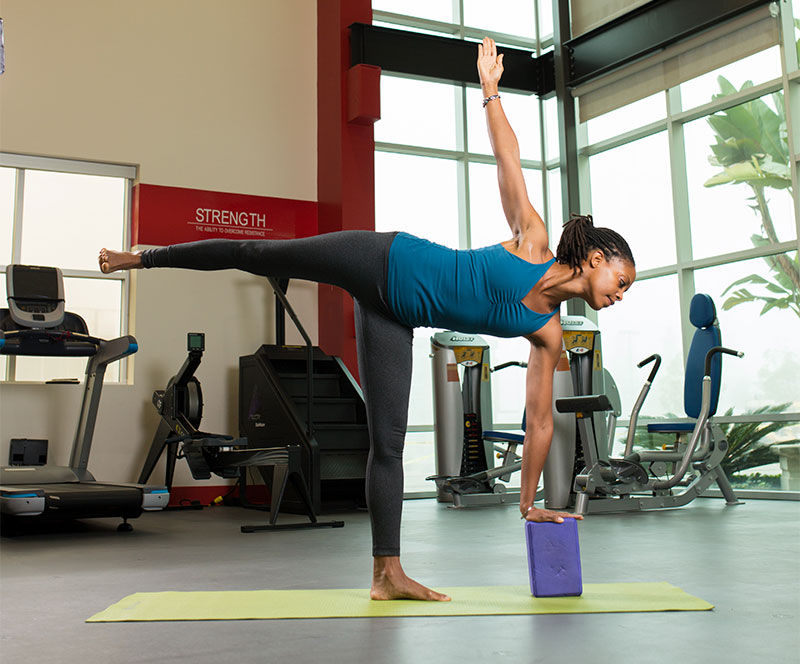While yoga can help improve flexibility, posture and balance, the practice of yoga offers so much more, including self-reflection, the practice of kindness to ourselves and others, and continued growth and self-awareness. Of course, all of this is much easier to move toward if you can find a sense of comfort in the poses.
Yoga provides many props to enhance your ability to express a yoga pose. One of the most popular yoga props to use in class is the yoga block. Made from foam, bamboo, wood or cork, the block is often used as an extension of the arms, but can also support the back, head and hips to help the body settle into a pose. Furthermore, yoga blocks:
- Support range of motion, thereby shortening the distance between you and the floor (“bringing the floor closer to you”).
- Assist in establishing correct alignment.
- Help make yoga accessible to beginners and to those experiencing injury or other physical limitations.
- Bring awareness to properly engage and support muscles in a specific pose.
- Can be placed at the low, medium and high positions to accommodate more or less support.
Whether you are seated or standing, or have tight hips and shoulders, the following four poses provide excellent examples of using a yoga block to enhance flexibility and find greater enjoyment in your yoga practice.
Virasana or Hero’s Pose | Seated Meditation
How: Kneel with your knees and feet hip-distance apart. Place the block between your shins on the medium-height level. Slowly shift your body back and sit on top of the block. Lengthen the spine, gently engage the core, and keep length in the back of the neck. Place palms on top of the thighs.
Why: Lifting the hips above the level of your knees will reduce knee stress and discomfort, making it easier for you to sit in this position to reap the benefits of stretching the feet, ankles and thighs.

Ardha Chandrasana or Half-moon Pose | Balance
How: Position the yoga block 6 to 12 inches in front of the standing foot, slightly to the outside and on the highest height level. From a high-lunge position with the right foot forward, place your hand on the block and use the block to extend up and out of the shoulder while stepping into the right foot and straightening the right leg. Lift the left leg up parallel to the floor. Roll the left hip up and back and turn the whole torso so that the entire front of the body is facing the sidewall.
Why: The block shortens the distance between the hand and the supporting surface (in a sense, it lifts up the floor to meet your hand), making it easier for you lift the torso, expand through the chest and keep the upper body in alignment without collapsing into the side body. When using the block to aid in balance, you’ll be able to slowly open the hips and reap the benefits of strong ankles, knees, legs and mental focus.

Supta Baddha Konasana or Reclining Bound Angle Pose | Hip Opener
How: You will need two blocks. Begin seated with your knees bent and feet on the floor. Gently let your knees fall open as the bottoms of the feet come together, and draw your heels toward your glutes. Place a block in the medium or low position underneath each thigh to support the weight of each leg. Lie down and place your arms at your sides.
Why: If the groin, inner thighs and hips are tight, you will feel a pulling sensation as the legs hang in space. The support of the blocks underneath the legs allows for the inner thighs and hips to release with ease.

Matseyasana or Fish Pose | Heart Opener
How: You will need two blocks. Begin seated with your knees bent and feet on the floor. Position one block at medium height where you think your shoulder blades will rest when you lie back. Place the other block at medium height where you think your head will rest. Gently lean back and release your shoulders blades slightly above the first block. Then release your head onto the second block. Allow the arms to relax at your sides.
Why: Many of our daily activities tend to pull the arms and shoulders forward, but the yoga block helps us to expand the torso and ribcage. While opening the chest, shoulders, neck and abdominals, you will help create space that will allow for deeper breathing.

Learn more about yoga tips and tricks to utilize with your clients with our yoga-based continuing education courses.




 by
by 








 by
by